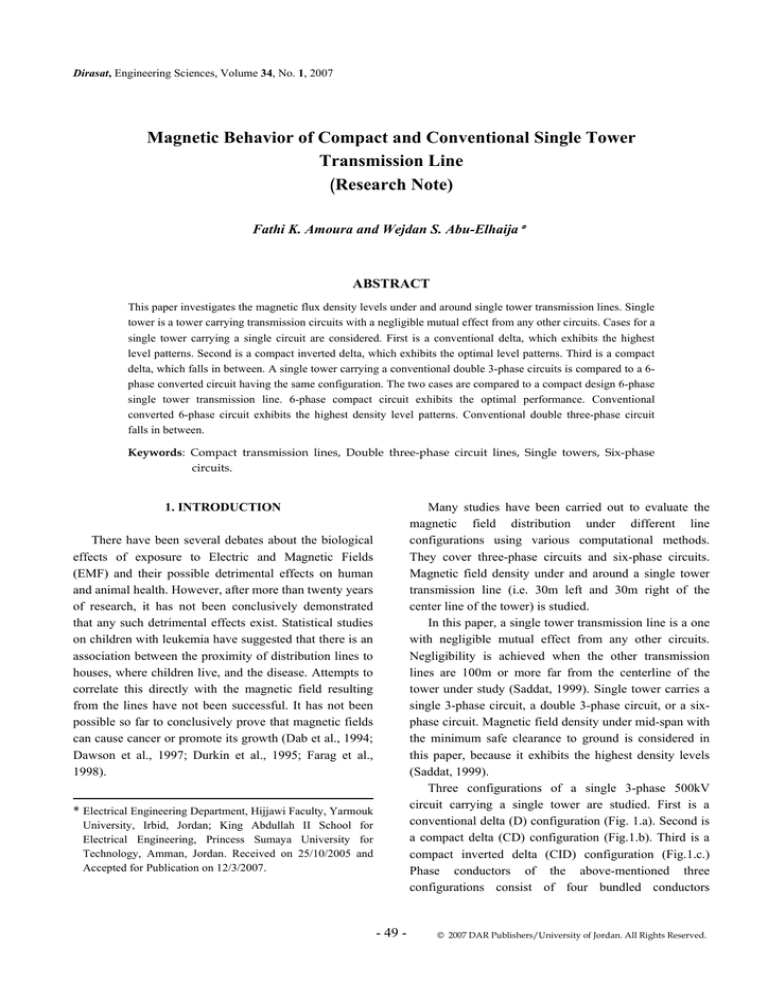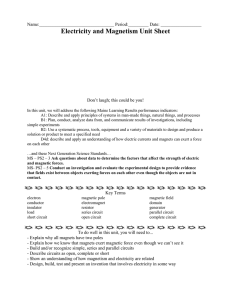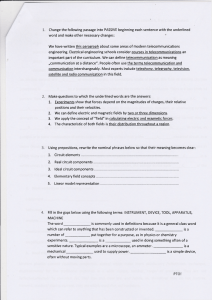
Dirasat, Engineering Sciences, Volume 34, No. 1, 2007
Magnetic Behavior of Compact and Conventional Single Tower
Transmission Line
(Research Note)
Fathi K. Amoura and Wejdan S. Abu-Elhaija*
ABSTRACT
This paper investigates the magnetic flux density levels under and around single tower transmission lines. Single
tower is a tower carrying transmission circuits with a negligible mutual effect from any other circuits. Cases for a
single tower carrying a single circuit are considered. First is a conventional delta, which exhibits the highest
level patterns. Second is a compact inverted delta, which exhibits the optimal level patterns. Third is a compact
delta, which falls in between. A single tower carrying a conventional double 3-phase circuits is compared to a 6phase converted circuit having the same configuration. The two cases are compared to a compact design 6-phase
single tower transmission line. 6-phase compact circuit exhibits the optimal performance. Conventional
converted 6-phase circuit exhibits the highest density level patterns. Conventional double three-phase circuit
falls in between.
Keywords: Compact transmission lines, Double three-phase circuit lines, Single towers, Six-phase
circuits.
Many studies have been carried out to evaluate the
magnetic field distribution under different line
configurations using various computational methods.
They cover three-phase circuits and six-phase circuits.
Magnetic field density under and around a single tower
transmission line (i.e. 30m left and 30m right of the
center line of the tower) is studied.
In this paper, a single tower transmission line is a one
with negligible mutual effect from any other circuits.
Negligibility is achieved when the other transmission
lines are 100m or more far from the centerline of the
tower under study (Saddat, 1999). Single tower carries a
single 3-phase circuit, a double 3-phase circuit, or a sixphase circuit. Magnetic field density under mid-span with
the minimum safe clearance to ground is considered in
this paper, because it exhibits the highest density levels
(Saddat, 1999).
Three configurations of a single 3-phase 500kV
circuit carrying a single tower are studied. First is a
conventional delta (D) configuration (Fig. 1.a). Second is
a compact delta (CD) configuration (Fig.1.b). Third is a
compact inverted delta (CID) configuration (Fig.1.c.)
Phase conductors of the above-mentioned three
configurations consist of four bundled conductors
1. INTRODUCTION
There have been several debates about the biological
effects of exposure to Electric and Magnetic Fields
(EMF) and their possible detrimental effects on human
and animal health. However, after more than twenty years
of research, it has not been conclusively demonstrated
that any such detrimental effects exist. Statistical studies
on children with leukemia have suggested that there is an
association between the proximity of distribution lines to
houses, where children live, and the disease. Attempts to
correlate this directly with the magnetic field resulting
from the lines have not been successful. It has not been
possible so far to conclusively prove that magnetic fields
can cause cancer or promote its growth (Dab et al., 1994;
Dawson et al., 1997; Durkin et al., 1995; Farag et al.,
1998).
* Electrical Engineering Department, Hijjawi Faculty, Yarmouk
University, Irbid, Jordan; King Abdullah II School for
Electrical Engineering, Princess Sumaya University for
Technology, Amman, Jordan. Received on 25/10/2005 and
Accepted for Publication on 12/3/2007.
- 49 -
© 2007 DAR Publishers/University of Jordan. All Rights Reserved.
Magnetic Behavior… (Research Note)
Fathi K. Amoura and Wejdan S. Abu-Elhaija
( 4 × 30mm diameter) per phase. Each phase bundle
carries 1000A (Abd-Allah and Alghamdi, 2001). A
conventional 115kV double 3-phase circuit (3D)
configuration carrying a single tower is also studied (Fig.
2.a). This configuration is compared with a 6-phase
circuit (6Con) carrying the above-mentioned single tower
(Fig. 2.b.). The configuration is a conversion of the
double 3-phase circuit using the same tower and the same
conductors and the same current. Converted six-phase
circuit is chosen normally to make an advantage of the
76% increase in power handling capability without
bothering the exiting accessible corridor (Sterwant et al.,
1992).
The last two configurations are compared with a
compact 6-phase circuit (6Com) carrying a single tower
(Fig. 2.c.), having the same conductors and the same
current as the two above-mentioned cases. It is a
favorable choice for new projects because it helps to
reduce the problem of the right of way.
Phase conductors of the above-mentioned three
configurations
consist
of
one
conductor
of
30mm diameter per phase. Each phase conductor carries
1000 A (Melo et al., 1999; Amoura et al., 2000).
Results in this paper help the designers to approach
the optimal design for both existing and future projects.
2. METHOD OF CALCULATION
r
Magnitude of the magnetic field intensity dH 2 at a
point 2 produced by a differential filamentary conductor
r
dL1 carrying current I1 is calculated as follows (Fig. 3)
(Hayt, 1989):
r
I1dL1 × aˆ R
r
12
dH 2 =
2
4π R12
(1)
r
H pi =
Ii
aˆ
2π R12 φ
A/ m
(2)
Where;
âφ : Unit vector normal to the distance R12
The three-phase circuits consist of three currentcarrying conductors with 120 o phase shift between the
currents. The 6- phase circuits consist of six currentcarrying conductors with 60 o phase shift between the
currents. The resultant magnetic field intensity at any
point, Say P , is the vector summation of the magnetic
field intensity caused by N current-carrying conductors of
the single tower. Horizontal and vertical components,
Equation.2, of the magnetic field intensity at the point P
as a result of a current, say I i , is;
H xpi =
H ypi =
I i cos θ
2π R pi
I i sin θ
2π R pi
aˆ x
(3)
aˆ y
(4)
Where:
H xpi : Horizontal component of the magnetic field
intensity at point P
H ypi : Vertical component of the magnetic field
intensity at point P
: Root mean square current
Ii
θ
: As defined in figure 4
R pi :
The distance between the current-carrying
conductor and the point of interest.
The resultant magnetic field intensity H tp of N
currents carrying N conductors of a single tower is;
N
N
H tp = ( ∑ H xpi ) 2 + ( ∑ H ypi ) 2
i =1
i =1
(5)
The resultant magnetic field density at the point P is
given by.
Where;
r
R12 : Normal distance from the differential element dL1
to the point 2.
aˆ R : Unit vector normal to the differential element and
12 the distance R .
12
Transmission line current carrying conductor can be
considered as an infinitely long straight filament carrying
a root mean square current I i (Fig. 4), equation (1) can be
r
developed and the magnetic field intensity H pi at the
point P is: (Hayt, 1989)
- 50 -
T
Btp = µ o H tp
µ o = 4π × 10 −7
H /m
(6)
3. RESULTS
3.1.
Single Circuit Carrying a Single Tower
Configuration
In Fig (5), the solid curve represents the D
configuration, the stars curve represents the CD
Dirasat, Engineering Sciences, Volume 34, No. 1, 2007
configuration, and the circles curve represents the CID
configuration. Comparing these curves shows that the D
configuration exhibits the highest density levels at all
locations. It shows also that CID configuration exhibits
the lowest density levels at all locations.
The D curve shows a spread peak around the
centerline of 21.5µT average value. Ten meters far from
the centerline, the density starts to drop sharply down to
about 5.5µT at 30m distance from the centerline.
Both the CD and the CID curves have a single peak
exactly at the centerline. The curve is sharper around the
peak in the CID than that in the CD. The CD peak value
amounts to 19µT and the lowest value drops down to
3µT at 30m far from the centerline. The CID peak value
amounts to 14.25µT and the lowest value drops to
2.5µT at 30m far from the centerline.
The CD configuration reduces the peak by 10.6% and
the CID configuration reduces the peak by about 34% and
the lowest level, at 30m far from the centerline, reduces
by more than 50%, all compared with the D
configuration.
It is important to observe that CID configuration has
one phase nearer to the ground while the other two phases
are at higher levels. The CD configuration has two phases
nearer to the ground level and one phase at a higher level.
The change in phase arrangement as transposition
takes place is studied and no change is noticed in
magnetic field density levels; and subsequently, curves
are not needed for this case.
circuits is tested and it does not result in any change in
the magnetic field density patterns. Subsequently, no
curves are needed.
Figure (7) shows three magnetic field density
distribution curves. The solid curve is for 3D
configuration with ABC-ABC phase arrangement taken
as a reference. The star curve is for 6Con configuration.
The circles curve is for 6Com configuration.
The 6Con configuration exhibits the highest density
level at all points. A single peak of 20µT occurs exactly
at the centerline. The density falls sharply down to
2.5µT at 30m far from the centerline.
The 6Com configuration exhibits the lowest density
level curve at all points. The 6Com curve has a single
peak of 5.9µT exactly at the centerline. The magnetic
field density falls sharply at 15m far from the centerline
and then slowly down to 0.4µT at 30 m far from the
centerline. Comparing the 6Com with the reference case,
the peak value drops by 55% and the minimum value
drops by 80%. Comparing the 6Con configuration with
the reference case, the peak increases by about 54% and
the minimum increases by about 20%.
The 3D configuration falls in between with a single
peak of 12.8µT that falls exactly at the centerline. The
minimum is 2.1µT at 30m far from the centerline.
3.2. Single Tower Carrying Double Three-Phase
Circuits or a Six- Phase Circuit
Figure (6) shows the distribution of the magnetic field
density under 3D configuration. The solid curve is for
ABC-ABC phase arrangement of the two three-phase
circuits top to bottom. The star curve is for ABC-CBA
phase arrangement of the two three-phase circuits top to
bottom. Comparing the two curves shows that changing
the phase arrangement leads to a change in the magnetic
field density distribution, in this case, ABC-CBA
arrangement in comparison with the, ABC-ABC
arrangement exhibits a 5µT reduction in the peak value
and 1.7 µT reduction in the minimum value.
The phase arrangement changes as transposition takes
place. Subsequently, worst case should be considered to
make sure that its level is below maximum permissible
limits.
Changing the phase arrangement in the six-phase
•
4. CONCLUSION
1.
•
II.
•
•
- 51 -
The single circuit carrying a single tower
configuration:
The change in phase arrangement does not affect the
shape or the level of the magnetic field density
patterns.
The compact inverted delta is highly recommended
for new projects because it exhibits the optimal
magnetic field density levels at all locations and
minimize the problems of the right of way.
The double three-phase circuit configurations and the
six-phase circuit configurations both carrying a single
tower:
The phase arrangement in the double three-phase
circuits give similar patterns but with different levels.
Careful examination of different flux density level
patterns should be studied as phase arrangement
change when transposition takes place. This is
necessary to insure that worst-case pattern levels are
lower than the maximum permissible levels.
For the six-phase circuit, the change in phase
Magnetic Behavior… (Research Note)
•
Fathi K. Amoura and Wejdan S. Abu-Elhaija
arrangement does not affect the shape or the level of
the magnetic flux density patterns.
Converting the existing double three-phase circuits to
a six-phase circuit is recommended to increase power
handling capacity by 76%, but it also increases the
magnetic flux density levels, subsequently, a careful
examination of magnetic flux density levels of the
•
converted circuit is necessary to insure that it is
below the maximum permissible levels.
The compact six-phase circuit is highly
recommended for new projects because it exhibits the
optimal magnetic field density patterns, and it can
handle higher power and reduce the problem of the
right of way.
a
b
c
Figure 1: A single tower carrying a single circuit configuration:
a. Conventional delta (D) configuration.
b. Compact delta (CD) configuration.
c. Compact inverted delta (CID) configuration.
- 52 -
Dirasat, Engineering Sciences, Volume 34, No. 1, 2007
a
b
c
Figure 2: A single tower carrying:
a. Conventional double three-phase circuit (3D).
b. Conventional converted six-phase circuit configuration (6Con).
c. Compact six-phase configuration (6Com).
- 53 -
Magnetic Behavior… (Research Note)
Fathi K. Amoura and Wejdan S. Abu-Elhaija
Figure 3: Illustration of equation (1)
Figure 4: Illustration of equations (2) to (5).
22
M agnetic Field dens ity (M ic ro Tes la)
20
18
16
14
12
10
8
6
4
2
-30
-20
-10
0
10
20
Dis tanc e from c enter line (m )
Figure 5: Magnetic flux density distribution of:
D (-), CD (*), CID (o)
- 54 -
30
Dirasat, Engineering Sciences, Volume 34, No. 1, 2007
14
M agnetic Field dens ity (M ic ro Tes la)
12
10
8
6
4
2
0
-30
-20
-10
0
10
20
30
Dis tanc e from c enter line (m )
Figure 6: Magnetic flux density level under 3D circuit
ABC-ABC phase arrangement (-), ABC-CBA (*).
20
M agnetic Field Dens ity M ic ro Tes la
18
16
14
12
10
8
6
4
2
0
-30
-20
-10
0
10
20
30
Dis tanc e from c enter line (m )
Figure 7: 3D circuit with ABC-ABC phase arrangement (-),
6Con circuit (*), 6Com circuit (o).
- 55 -
Magnetic Behavior… (Research Note)
Fathi K. Amoura and Wejdan S. Abu-Elhaija
REFERENCES
1995. Five Years of Magnetic Field Management. IEEE
Transaction on Power Delivery, 10 (1): 219-228.
Farag, A.S. et al. 1998. Magnetic Field Measurement and
Management in and Around Substations in Saudi Arabia.
CIGRE, Paper 36-201, Paris.
Hayt, W. J.R. 1989. Engineering Electromagnetics,
McGraw-Hill Book Company, 50-70.
Melo, M.O., Fonseca, L.C, Fontana, E. and Naidu,
S.R.1999. Electric and Magnetic Fields of Compact
Transmission Lines. IEEE Transaction on Power
Delivery, 14 (1): 200-204.
Saddat, H. 1999. Power System Analysis, McGraw Hill
Book Company, 20-40.
Sterwart, J.R., Oppel, J., Thomann, G.C, Dorazio, T.F. and
Brown,
M.T.1992.
Insulation
Coordination,
Environmental and System Analysis of Existing Double
Circuit Line Reconfigured to Six-Phase Operation. IEEE
Transactions on Power Delivery, 7 (3):1628-1633.
Abd-Allah, M.A. and Alghamdi, A.S. 2001. Magnetic Field
Mitigation Using Line Compaction. The 8th International
Middle-East Power Systems Conference (MEPCON),
Cairo, Egypt.
Amoura, F., Basha, A.M., Emasry, E.S. and Afzal, A. 2000.
High Phase Order Transmission (6-phase)- An
Overview. Water and Energy International Journal, 57
(1).
Dab, W., Lambrozo, J. and Souques, M. 1994. Magnetic
Fields and Cancer: Recent Studies in Adults. CIGRE,
panel 1-03, Paris.
Dawson, T.W., Caputa, K. and Stuchly, M. 1997. Influence
of Human Model Resolution on Computed Currents
Induced in Organs by 60-Hz Magnetic Fields.
Bioelectromagnetics, (18): 478-490.
Durkin, C.I., Fogarty, R.P., Halleran, T.M. and Mark, D.A.
ﺍﻟﺴﻠﻭﻙ ﺍﻟﻤﻐﻨﺎﻁﻴﺴﻲ ﻟﺒﺭﺝ ﻤﺴﺘﻘل ﺤﺎﻤل ﻟﺨﻁﻭﻁ ﺍﻟﻨﻘل ﺍﻟﻜﻬﺭﺒﺎﺌﻲ
ﻓﻲ ﺤﺎل ﻜﻭﻨﻪ ﻤﻀﻐﻭﻁ ﹰﺎ ﺃﻭ ﺘﻘﻠﻴﺩﻴ ﹰﺎ
()ﻤﻠﺤﻭﻅﺔ ﻋﻠﻤﻴﺔ
*ﻓﺘﺤﻲ ﻜﺎﻤل ﻋﻤﻭﺭﺓ ﻭﻭﺠﺩﺍﻥ ﺼﺎﻟﺢ ﺃﺒﻭ ﺍﻟﻬﻴﺠﺎ
ﻤﻠﺨﺹ
ل ﺒﺭﺝ ﻤﺴﺘﻘل ﺤﺎﻤل ﻟﺨﻁﻭﻁ ﺍﻟﻨﻘل
َ ﺤﻭ
ﺘﺒﺤﺙ ﻫﺫﻩ ﺍﻟﻭﺭﻗﺔ ﻓﻲ ﻁﺭﻴﻘﺔ ﺤﺴﺎﺏ ﻤﺴﺘﻭﻴﺎﺕ ﻜﺜﺎﻓﺔ ﺍﻟﻤﺠﺎل ﺍﻟﻤﻐﻨﺎﻁﻴﺴﻲ ﺘﺤﺕ ﻭ
ﺍﻷﻭﻟﻰ ﺘﺸﻜﻴﻠﺔ: ﺘﻤﺕ ﺩﺭﺍﺴﺔ ﻋﺩﺓ ﺤﺎﻻﺕ. ﺍﻟﺒﺭﺝ ﺍﻟﻤﺴﺘﻘل ﻫﻭ ﺍﻟﺫﻱ ﻻ ﺘﺄﺜﻴﺭ ﺤﺜﻴﹰﺎ ﻋﻠﻴﻪ ﻤﻥ ﺃﻱ ﺩﺍﺌﺭﺓ ﻜﻬﺭﺒﺎﺌﻴﺔ ﺃﺨﺭﻯ.ﺍﻟﻜﻬﺭﺒﺎﺌﻲ
ﺘﻤﺕ ﻤﻘﺎﺭﻨﺔ ﺍﻟﺒﺭﺝ ﺍﻟﻤﺴﺘﻘل ﺍﻟﺤﺎﻤل ﻟﺩﺍﺌﺭﺘﻴﻥ. ﻭﺍﻟﺜﺎﻟﺜﺔ ﺍﻟﺩﻟﺘﺎ ﺍﻟﻤﻀﻐﻭﻁﺔ، ﻭﺍﻟﺜﺎﻨﻴﺔ ﺍﻟﺩﻟﺘﺎ ﺍﻟﻤﻘﻠﻭﺒﺔ ﻭﺍﻟﻤﻀﻐﻭﻁﺔ،ﺩﻟﺘﺎ ﺍﻟﺘﻘﻠﻴﺩﻴﺔ
ﺃﻁﻭﺍﺭ-6 ﻭﺘﻤﺕ ﻜﺫﻟﻙ ﺍﻟﻤﻘﺎﺭﻨﺔ ﻤﻊ ﺒﺭﺝ ﻤﺴﺘﻘل ﺤﺎﻤل ﻟﺩﺍﺌﺭﺓ.ﺃﻁﻭﺍﺭ-6 ﺘﻘﻠﻴﺩﻴﺘﻴﻥ ﻤﻊ ﻨﻔﺱ ﺍﻟﺘﺭﺘﻴﺒﺔ ﺒﺘﺤﻭﻴل ﺍﻟﺩﺍﺌﺭﺘﻴﻥ ﺇﻟﻰ ﺩﺍﺌﺭﺓ
ﺃﻁﻭﺍﺭ ﺍﻟﺘﻘﻠﻴﺩﻴﺔ ﺘﻌﻁﻲ ﺃﺴﻭﺃ-6 ﺃﻁﻭﺍﺭ ﺍﻟﻤﻀﻐﻭﻁﺔ ﺘﻌﻁﻲ ﺃﻓﻀل ﺍﻟﻨﺘﺎﺌﺞ ﺒﻴﻨﻤﺎ ﺩﺍﺌﺭﺓ-6 ﺃﻅﻬﺭﺕ ﺍﻟﺩﺭﺍﺴﺔ ﺃﻥ ﺩﺍﺌﺭﺓ.ﻤﻀﻐﻭﻁﺔ
. ﺃﻁﻭﺍﺭ ﺒﻴﻨﻬﻤﺎ-3 ﻭﺘﻘﻊ ﺩﺍﺌﺭﺘﺎ،ﺍﻟﻨﺘﺎﺌﺞ
. ﺨﻁﻭﻁ ﺍﻟﻨﻘل ﺍﻟﻤﻀﻐﻭﻁﺔ، ﺃﻁﻭﺍﺭ، ﺩﺍﺌﺭﺓ، ﺒﺭﺝ ﻤﺴﺘﻘل، ﺍﻟﺴﻠﻭﻙ ﺍﻟﻤﻐﻨﺎﻁﻴﺴﻲ، ﺨﻁﻭﻁ ﺍﻟﻨﻘل ﺍﻟﻜﻬﺭﺒﺎﺌﻲ:ﺍﻟﻜﻠﻤﺎﺕ ﺍﻟﺩﺍﻟﺔ
________________________________________________
ﺠﺎﻤﻌﺔ، ﺍﻷﺭﺩﻥ؛ ﻜﻠﻴﺔ ﺍﻟﻤﻠﻙ ﻋﺒﺩ ﺍﷲ ﺍﻟﺜﺎﻨﻲ ﻟﻠﻬﻨﺩﺴﺔ ﺍﻟﻜﻬﺭﺒﺎﺌﻴﺔ، ﺇﺭﺒﺩ، ﺠﺎﻤﻌﺔ ﺍﻟﻴﺭﻤﻭﻙ، ﻜﻠﻴﺔ ﺍﻟﺤﺠﺎﻭﻱ،* ﻗﺴﻡ ﺍﻟﻬﻨﺩﺴﺔ ﺍﻟﻜﻬﺭﺒﺎﺌﻴﺔ
.2007/3/12 ﻭﺘﺎﺭﻴﺦ ﻗﺒﻭﻟﻪ،2005/10/25 ﺘﺎﺭﻴﺦ ﺍﺴﺘﻼﻡ ﺍﻟﺒﺤﺙ. ﺍﻷﺭﺩﻥ، ﻋﻤﺎﻥ،ﺔ ﻟﻠﺘﻜﻨﻭﻟﻭﺠﻴﺎﺍﻷﻤﻴﺭﺓ ﺴﻤﻴ
- 56 -




